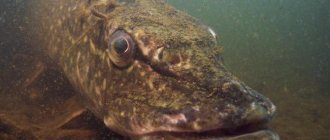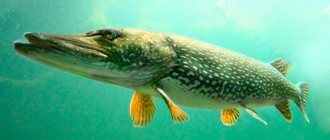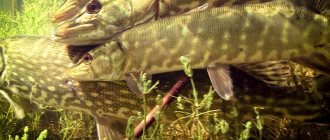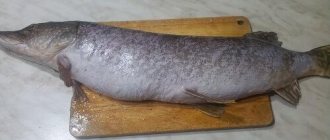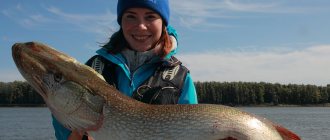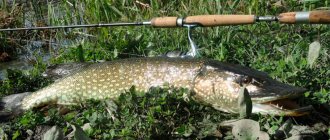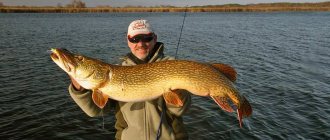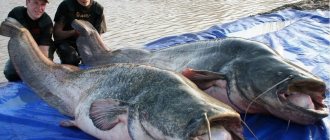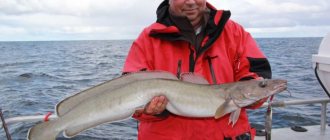how long does a pike live?
hmm I was reading Sabaneev’s pike here
and was quietly amazed
In Western Europe, giant pikes were found in the 19th century, and in the past and in the Middle Ages they were even common. Back in 1862, according to Genzik, transmitted by Borne, a pike weighing 58 kg was caught in Bregenz. The largest pike ever caught is the historical pike of Emperor Frederick II Barbarossa, which he released, as stated on the ring, in 1230 into a lake near Heilbronn and was pulled out with a seine in 1497, i.e. 267 years later. The fish turned completely white from old age. Its size was 5.7 m, and it weighed 140 kg. The portrait of this pike is still preserved in Lautern Castle, and the skeleton and ring are in Mannheim. There is no doubt that pikes can live for hundreds of years. Near Moscow, while cleaning the Tsaritsyn ponds (at the end of the last century), a 2-meter pike with a gold ring in the gill cover and with the inscription: “planted by Tsar Boris Fedorovich” was caught. In all likelihood, she weighed about 64 kg. Blancher says that in 1610 a huge pike was caught in the Meuse with a copper ring on which was marked the year 1448.
From Wiki The maximum age of pike in commercial catch at the present time, as well as over the past several centuries, does not exceed 25 years. The catch of a 33-year-old pike is reliably documented. Stories in popular literature about pikes of much older age should be classified as legends.
Particularly popular among stories of this type is the story of the “Heilbronn pike,” which allegedly was caught personally by Emperor Frederick II in October 1230, marked with a gold ring and released into Lake Bjockingen near Heilbronn, where this pike was caught 267 years later, in 1497. At the same time, it reached a length of 570 centimeters and weighed 140 kg. The spine of this pike was deposited in the Mannheim Cathedral.
This story aroused the interest of the German natural philosopher Oken. Oken studied the historical chronicle in detail and found that Frederick II at that time lived constantly in Italy and could not in any way identify the pike on German territory. It was also possible to examine the spine of a giant pike, exhibited in Mannheim Cathedral. It turned out that this was a falsification, and that it was assembled from the vertebrae of several individual pikes.
Structural features of pike
Pike is easy to distinguish from other freshwater predatory fish, primarily due to its elongated, arrow-shaped body. The head is also elongated, which is why it is often compared to a fox. The lower jaw protrudes slightly forward. There are several dozen teeth on the lower jaw. In this case, teeth most often have different sizes. Thanks to this feature, the pike is able to hold fish of almost any size. The upper jaw, tongue, and some bones of the mouth also have teeth, but they are smaller than those found on the lower jaw. The teeth are directed with sharp parts towards the throat. If necessary, they are immersed in the mucous membrane. Thanks to this, the prey passes into the throat without resistance. But if the fish tries to escape, the teeth sink into the body. The pike's mouth is capable of holding prey only half its own size.
It has been scientifically proven that pike change teeth on the lower jaw. This is how the replacement teeth are located in the soft tissue. If the main tooth is lost, a replacement tooth quickly takes its place.
Teeth are replaced throughout the year as needed, which means they do not affect the intensity of the bite.
The dorsal fin of the pike is shifted towards the tail. This is another feature that distinguishes it from other fish. As for the color of the pike, it depends on the environment in which the predator lives. The color is dominated by green and gray colors. The back is even black. While the belly is white or yellow. The sides of the fish are green and decorated with brown and olive spots. Sometimes the spots even form transverse stripes on the body of the fish. But the muskie, which is a close relative of the pike, has a silvery body.
Muskinong is the largest representative of the pike family. The size of an adult can exceed 30 kg. Lives in North America.
The oldest fish in the world lived to be 112 years old
Have you ever wondered how many years fish live? Based on the fact that most of them have to live next to dangerous predators in very unpleasant conditions, one might think that they live no more than two or three years. However, this is far from true - a 112-year-old fish was recently found in the waters of the American state of South Dakota. According to scientists, she was born in 1907, when the Titanic had not yet set off on its tragic voyage, and no one even suspected the imminent outbreak of the First World War.
The fish found is a largemouth buffalo (Ictiobus cyprinellus). The average lifespan of representatives of this species is about 26 years. The found individual lived four times longer than most of its relatives and gained 22 kilograms of weight throughout its long life, which is quite impressive for a fish of this species. However, this is far from a record weight - in history there was a case when people caught a 30-kilogram individual.
Pike in our reservoirs
Everyone has heard about pike; it is probably impossible to find a person in the Northern Hemisphere who does not know this aquatic predator. In Russia, Belarus, and Ukraine, many grew up on fairy tales and cartoons, where often the main character was this toothy inhabitant of rivers and lakes. Many fishing enthusiasts are familiar with it personally; spinning anglers especially often encounter it; for them its size is very important.
No one can say exactly how many years a pike lives; it has long been believed that in distant northern reservoirs it lives for 100 years. It has been officially proven that under ideal conditions the maximum lifespan can be no more than 30 years in waters with a decent oxygen content. Most often it lives 10-20 years if it does not get hooked by a fisherman.
- A story about a pike - a description for 1st grade students
It will not be possible to identify yourself when catching this predator; it has specific characteristic features:
| components of a predator | characteristics |
| body shape | torpedo-shaped, elongated |
| color | grayish green to dark brown, back darker than belly |
| muzzle | elongated, lower jaw protrudes slightly forward, eyes set deep |
| teeth | located on the jaws, additionally there are sharp bristles on the tongue |
The main feature of pike is the presence of spots on the body, but this applies only to an ordinary individual that lives in the northern part of Eurasia.
How long do fish live?
The lifespan of fish depends on their species and their habitat. It is quite logical that tiny aquarium fish can live for quite a long time thanks to a safe environment - the main thing is that the owners clean the water on time and do not forget to feed them. Fish living in the wild constantly risk their lives because they can become prey to predators and fishermen.
Lifespan of fish:
- Pike - 7 years;
- Salmon - 15 years;
- Mackerel - 20 years;
- Carp - 20 years;
- Perch - 23 years old;
- Sturgeon - 100 years old.
For a long time it was believed that the longest-living fish were pikes. In particular, the authors of some books claimed that in 1794, near Moscow, fishermen caught a pike with a ring stuck to its gills with the inscription “Planted by Tsar Boris Fedorovich.” It is known that Boris Godunov ruled from 1598 to 1605, that is, the pike was about 200 years old. Of course, due to the lack of any evidence, this story is just a legend.
Why don't fish reproduce?
It turned out that in the late 1930s a dam was built in the city, which blocked the fish from reaching their breeding site. Ultimately, it turned out that practically no new fish were born in the vicinity of the city, and the water was almost always inhabited by individuals born during the war. They were able to survive because they are almost never eaten and can only be caught for sporting purposes. Apparently sport fishing isn't very developed in Minnesota.
Do you know what disease a fish diet helps with?
Carp fishing in the USA - why don’t they like them?
Through it all, largemouth buffalo provide enormous benefits to local rivers. The fact is that they are actively destroying carp, which were brought to the United States in the 1970s from the Kazakh Lake Balkhash. Fish alien to American waters have multiplied and begun to eat local fish - some species are already on the verge of complete extinction. And the carps themselves are practically not interesting for Americans - while in Russia they are happily caught and eaten, in the USA they are not liked because of the abundance of seeds.
As you can see, even such inconspicuous creatures as fish are still capable of surprising us. Another amazing fish is the blue-headed thalasoma, the females of which can turn into males in a very short time. It takes them about 10 days to completely change their appearance and character. But the most interesting thing is that they change gender for a reason - there are extremely compelling reasons for this.
If you are interested in science and technology news, subscribe to our channel in Yandex.Zen. There you will find materials that were not published on the site!
How old can a pike live?
Based only on data verified by scientists, it is worth noting that the real age of pike can reach 30-33 years. The mass of the predatory fish is about 40 kg, with a length of 180 cm.
On the Internet you can find information that the maximum age of pike in the wild does not exceed seven years, with a maximum weight of 16 kg. This information is fundamentally incorrect and misleads readers. Quite serious studies have been carried out in the USA regarding the maximum age of pike. A special progressive technique has been developed to reduce possible errors to a minimum. As a result, it was possible to find out that the maximum age of local pikes rarely exceeds 24 years. Swedish ichthyologists were able to prove that among pikes, specimens over 15 years of age are quite common. Scientists from Finland have found that a pike usually gains a weight of 7-8 kg by the age of 12-14 years.
Facts about catching giant pike:
- In 1930, in Russia, a giant pike weighing 35 kg was caught on Lake Ilmen.
- In New York State, a huge pike weighing 32 kg was caught on the St. Lawrence River.
- On Lake Ladoga and the Dnieper, fishermen caught pike weighing 20-25 kg. Moreover, catching such a large pike in those places was not considered something unusual.
- In 2013, on one of the lakes in the Republic of Tyva, Russian President V.V. Putin caught a pike weighing 21 kg.
And there are many similar facts; with the development of information technology, their number is constantly growing.
Pike spawning in spring
With the arrival of spring, pike representatives emerge from the holes, disperse and begin to swim near the edges. They no longer go into the depths and hide in secluded places, but rise up rivers and streams, and after one or two weeks, usually with the rivers and streams flooding, the pike begin their spawning. Typically, toothy predators do not spawn in the beds of large and medium-sized rivers; pike always go to shallower streams and rivers or later flooded areas with floods, usually in flooded lakes and coastal floods.
In central Russia, pike spawning usually occurs in March, but closer to the north it usually occurs in early or mid-April. In general, pike spawn in lakes later than in rivers, this is due to their late opening. In some Trans-Ural mountain lakes, this fish usually spawns at the end of May. But in the rivers of southern Russia, on the lower Volga, and the lower reaches of the Don and Dnieper, the toothy fish generally begins to spawn in February.
The entire spawning period lasts about a month, first small three-year-old pike spawn, and after all, the largest individuals of the pike family spawn. Pike spawning usually occurs as follows, three or four pikes each, which usually includes one female and two or three males next to her. As a result of this, most of the spawned eggs are fertilized, which cannot be said about other fish, in which the lack of males during spawning and confusion leads to the loss of eggs in vain.
With such a huge amount of pike caviar, the likelihood of further extermination of all other species of fish would be inevitable if most of the spawned eggs did not remain on drying spills and shallows, and also many pike fry did not disappear there. And part of the pike caviar becomes prey for birds of prey. The first time in its life a pike usually spawns in the third year, when its size reaches more than 32 cm.
Greenish-yellow and very small pike eggs are swept directly to the bottom, usually onto last year’s grass and laid in one layer. And the males fertilize her, releasing milk. The amount of caviar is very significant, but relatively less than that of perch, crucian carp and many other fish. The development of pike caviar proceeds quite quickly; for this, the optimal water temperature is plus 8-10 ℃.
In the sun and in shallow water, young bee-eaters hatch after 8-12 days, in the shade and in deeper places, after two weeks or more. At first, the juveniles hide in the moss, in the thick grass near the shore, and very soon, as soon as the yolk bubble disappears and the pike fry feel the need for food, they quickly disperse and then are no longer found in large numbers in one place.
At first, young bee-eaters live in the smallest places and are a little timid; they feed on insects, worms and various small invertebrates. In August and September, the squirrels already feed exclusively on small fish and quickly grow in size. In May, squints are still less than 4 cm, in June a little more, and in October they are already more than 15 cm in length and weighing more than 100 grams. Then during the winter they barely grow until the following early spring. And then the toothy predator grows extremely quickly.
